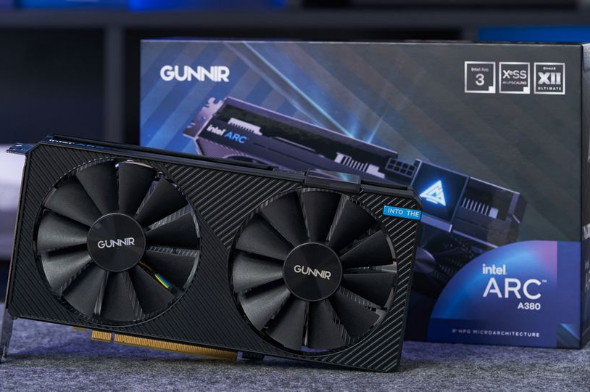Connection to DriversCloud Create a DriversCloud.com account Reset your DriversCloud.com password Account migration
Arc Alchemist: Intel details the performance of its high-end mobile solutions
While waiting for the presentation of the desktop models, Intel compares its Arc A730M and A770M to the GeForce RTX 3050 Ti and RTX 3060.
Published only a few days ago, the first independent test of an Arc A380 graphics card had disappointed us, that's nothing to say. Of course, Intel has never claimed that its graphics solution would be able to upset the gaming PC hierarchy, but we still didn't expect to discover a card that would be unable to stand up to a very modest GeForce GTX 1650... a card that NVIDIA has been distributing for more than two years and whose architecture is nothing new. We can console ourselves by saying that Intel certainly has in mind to distribute the A380 at a very low price. At least, we can hope so.
It is also to be hoped that the A5xx and A7xx models will be more powerful so that gamers will finally be able to consider something other than the endless duel between GeForce and Radeon, between NVIDIA and AMD. On this subject and even if Intel does not yet speak of graphics cards for desktop PCs, it has just presented quite detailed information on the mobile versions of its most powerful GPUs. Relayed by WCCFTech, the information in question is official. Communicated by Intel, they obviously commit the American, but are also to be seen as an element of communication of the electronics giant: we must wait for independent tests to disentangle the real from the simple marketing speech.
Intel specifies that the Arc 770M is based on an ACM-G10 GPU in a "full" version (32 Xe-Cores, 4096 ALUs, 32 ray tracing units). It is clocked at 1.65 GHz and relies on 16 GB of GDDR6 with 256-bit bus. If the A730M uses the same GPU, it is an "incomplete" version (24 Xe-Cores, 3,072 ALUs, 24 ray tracing units) clocked at 1.1 GHz and supported by "only" 12 GB of GDDR6 on 192-bit bus. Two graphics cards that Intel has thus opposed to two models from NVIDIA via four laptops: Arc A770M - Pre-Production Laptop (Core i9-12900HK, 16GB DDR5-4800); Arc A730M - Pre-Production Laptop (Core i7-12700H, 16GB DDR5-4800); RTX 3060 - MSI Pulse GL66 (Core i7-11800H, 16GB DDR4-3200); RTX 3050 Ti - MSI ROG Zephyrus M16 (Core i7-11800H, 16GB DDR4-3200)
The tests carried out by Intel were based on a series of games, as if to prove the gamer behavior of these graphics solutions, but also their ease of use in front of any title. In order to make things easier to understand for everyone, WCCFTech compiled all the results in a table, highlighting the two "duels" imagined by Intel. We can see that the Arc A730M has an average advantage of 13% over the GeForce RTX 3050 Ti while the Arc A770M outperforms the GeForce RTX 3060 by about 12%. Interesting results that should not hide a notable difference, the Intel solutions used a much higher TGP than NVIDIA GPUs:
- Intel Arc A770M (120 - 150 W)
- Intel Arc A730M (80 - 120 W)
- NVIDIA RTX 3060 (85 W Max-Q)
- NVIDIA RTX 3050 Ti (60 W Max-Q)
Before rejoicing and praising Intel, it will be important to check if the performance gaps are maintained at more or less equal TGP. This is undoubtedly not the least important, we will also have to monitor the availability and pricing of laptops equipped with A730M / A770M. Finally, let's keep in mind that Intel's return to the dedicated GPU market is somewhat delayed. In its comparison, the American company contrasts its GPUs that are not yet available with NVIDIA solutions that have already been on the market for a year. The response from the GeForce developer will probably not be long in coming.







